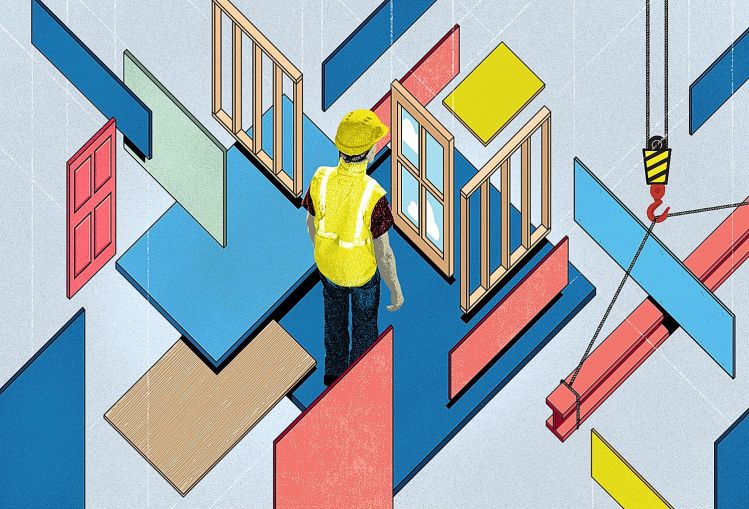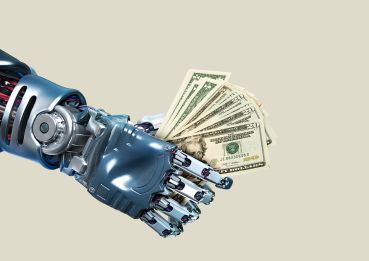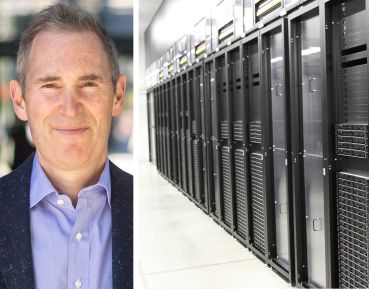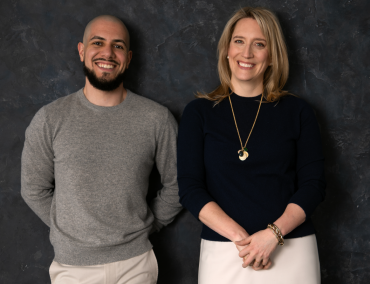AI Use Builds in the Construction Industry
Pros in the field call artificial intelligence the biggest thing to happen to building since the mobile phone
By Philip Russo January 30, 2024 6:00 am
reprints
Over the last year, artificial intelligence (AI) has quickly evolved from a tantalizing technical novelty like ChatGPT into a credible and valued asset for all industries, including the once-Luddite construction industry.
Proptech and contech experts are in full agreement that rapidly iterating AI technology is now in great demand by users and investors alike.
Technologists like Wyatt Jenkins, chief product officer at Santa Barbara-based contech giant Procore, have seen what he calls “AI waves” since the 1980s, but Jenkins said we are in a new era.
“It’s my opinion that this wave, the large language model (LLM) ChatGPT wave, is probably the biggest and most impactful one we’ve had,” said Jenkins. “For me as a technologist for almost 25 years, it’s on the level of almost mobile. When mobile [phones] came, that was like, ‘Oh wow, this is a shift. There’s a new platform.’ This technology shift to large language models is probably going to be in that same vein as when mobile changed a lot of things.”
AI has morphed from “old tech” of natural language processing in the 1980s, to computer vision — such as facial recognition — to harnessing large data sets to produce predictive analytics, Jenkins said. “We have R&D people who are experts in each of those. And now we have people who are becoming experts in large language models or prompt engineering, which is the new wave and is having a significant impact.”
As part of Procore’s mission to digitize construction, in 2020 it acquired Avata Intelligence, an AI predictive analytics company, followed in 2021 by the acquisition of Indus.ai, which does computer vision progress tracking, said Jenkins.
“For construction technology, the trifecta of computer vision, machine learning and generative AI is really going to reshape the built environment, because AI is going to power dynamic predictions that respond to all the different changing conditions on a job site.”
However, AI’s job replacement impact probably will be felt less by manual laborers working on site, and felt more by construction industry accountants and lawyers paid to analyze large sets of information, he said.
Enthusiasm over AI in construction is shared by venture capital firms such as Prudence, a global proptech/contech company that invests in real estate, particularly construction technology. In October 2023, the firm led a $14 million Series A round for AI Clearing (AIC), a proptech/contech company that developed an AI application for tracking progress and quality control on large infrastructure construction sites, enabling autonomous real-time oversight.
“Since the beginning of 2021, construction tech has seen $3 billion in VC deployment for AI-enabled solutions and $30 billion in deployment in 2023 from private capital,” said Gavin Myers, managing partner at Prudence, citing Construction Dive statistics.
“AI Clearing’s growth from zero to millions in annual recurring revenue in 12 months underscores the urgency of incorporating technology to augment productivity,” Myers said. “This growth suggests a swift adoption of AI solutions in the construction industry, particularly for progress tracking and quality control.”
Myers and Prudence started out as generalist technology investors, but through an early investment in real estate brokerage Compass began to focus on real estate and construction tech. He has found that other generalist VCs have become attracted to the opportunities in the construction industry.
“I think it’s because the solutions required are very technical,” Myers said. “There are a lot of different types of AI that can be used. Everybody thinks about the generative AI level, but there’s a lot of different types of AI, and one form is computers actually understanding what they’re looking at and being able to identify exactly what is in that image without human intervention. Computer vision has a great application in construction. You have a match with architecture, engineering and construction. The architectural part is something where generative AI has a natural application.”
In an increasingly competitive environment, VCs interested in investing in construction AI must be “hyper-focused on technical differentiation and defensibility,” Myers said. “Defensibility right now is one of the trickier ones because if you’re looking at just the workflow of a vertical SaaS workflow software platform, it’s a fair question to say, ‘Will AI build something comparable and more quickly and not take the three years of people, processes and capital to build?’ ”
Discerning true AI technology takes a lot of experience and drilling down into the companies that claim to provide it, said Robert Ioanna, chief technical officer with Syska Hennessy Group, an MEP engineering firm. Its investment subsidiary, Syska Innovations, explores opportunities in AI startups.
“We’re actively out in the market looking for startup companies,” said Ioanna. “We’ve been doing this for almost four years. We look at AI as another sort of technology, whether it’s drones or reality capture. As companies come to us and they propose their plans, if they have some sort of AI embedded or whether they don’t, it’s always a question we ask: ‘How are you using AI in your idea you’re proposing?’ And almost every single company claims that they’re using AI, but the difference between AI and what we call robotic process automation, RPA for short, is blurred very easily. Robotic process automation is just automated steps in a process, but the process can be very hairy and discombobulated.”
The difference with AI, Ioanna said, is machine learning.
“So that when you’re telling it to do something, the program itself is adjusting to the inputs that it’s given to create an output,” he explained. “There’s a major difference there. A lot of companies don’t know that. So sifting through the companies that say they’re using AI versus those who are just doing some very intelligent automation is the first task with almost every company that’s coming to us. What we’re finding is that maybe 80 percent of the companies are claiming they’re using AI and they’re not.”
Syska has invested in Shadow Ventures, a contech and real estate investment fund, which in turn funded Okibo, a startup that makes smart robots for construction sites.
“Robotics is just building a robot that can paint the wall,” said Ioanna. “The AI is actually scanning the wall continuously to know how much spackle to put on, where the tape is going, and then it can analyze where the end of the wall is. It can look at the coverage. It’s like the robot vacuum that you put in your house.”
The line between robotics and AI has definitely been erased, as the former invariably includes the latter these days, said Mark Martin, general partner at Boston-based Cybernetix Ventures, an early-stage robotics automation and AI venture capital fund that has invested in AI robotics startups such as AirWorks, Raise Robotics and Kewazo.
“What’s happening in the construction industry right now is you have lots of examples where there are clear use cases, there’s a clear value proposition, and robotics can deliver pretty quickly a strong ROI,” said Martin. “The economics of deploying robots has been pretty clear for the last few years, but with the labor shortage becoming so acute, we’re seeing people get serious about looking at new technologies available.
“One of our portfolio companies, Rugged Robotics, does semi-autonomous layout printing. Instead of multiple trades snapping chalk lines on massive construction projects, you can get a robot to do the job as accurately, if not more accurately, than a human. It will ingest the construction drawing, and you not only print the line, but you can print any additional information that you want, which can help speed up downstream construction projects as well.”
Determining what AI-based startup to invest in is an ongoing challenge for investors, said Sarah Liu, partner and co-leader of the early-stage proptech fund at venture capital firm Fifth Wall.
“Vetting an AI startup today is more challenging than maybe vetting your typical standard software company, because on the AI front the technology fundamentally is evolving so quickly,” said Liu. “And so a lot of tools out there might not have a stability that some of your standard software tools could count on having because the foundational tech is evolving and moving so fast. You really have to think about the team more than anything else, because you’re almost certain that the architecture and structure of the product is going to change over time due to how fast that technology is evolving.”
One early-stage AI contech company Fifth Wall has invested in is Trunk Tools, which uses its software to link on-site workers on a shared communications platform with management.
“We scroll through millions of documents that every project has, we go into the API of Procore, Autodesk, SharePoint and wherever data lies, and then we give all of the data back to the actual people in the field via text message,” said Sarah Buchner, CEO and founder of Trunk Tools. “They can send a text message to a specific phone number and be like, ‘Hey, what color paint do they use in the lobby?’ and within a few seconds we give them a specific type of Benjamin Moore and we give them a link to the request for information where this decision was made, instead of them going through thousands of pages of documents.”
Whatever the challenges of vetting AI contech startups, there are plenty to be found popping up in the industry.
In early January, New York City-based Poliark, an architecture and environmental technologies company that uses AI to build models for sustainable buildings, launched its new AI platform, Kend, which makes 3D models in seconds for architects and engineers.
“We are an AI and research company,” said Eda Erol, the founder and CEO of Poliark. “Basically what we do is we build an AI from scratch to take over the 2D and 3D modeling processes. With a simple text-based prompt it designs the entire model for you and has a built-in environmental catalog that calculates embedded carbon emissions from the get-go.”
Another early-stage startup in the field is Roofer.com, which uses AI algorithms and drone technology to conduct roof scans for roofing residential homes, as well as a growing enterprise segment that services multifamily apartments and commercial buildings.
The company announced Jan. 30 that it closed a $7.5 million seed round led by Mucker Capital with participation from Asymmetric Capital Partners, Soma Capital, HF0, Alumni Ventures, HustleFund, The Council, GoAhead Ventures, Mirada Capital and several angel investors.
“We are a roofing on demand company, and we use drones and AI to basically make that process more efficient,” said Nathan Mathews, co-founder and CEO of Roofer.com. “We have drones that gather images through licensed pilots who are actually manning the drone, and then we process that through our own computer vision software, which auto-identifies impacts and punctures to the roofing system.”
More established proptech/contech startups using AI are OnSiteIQ, whose software visualization platform is designed to mitigate risks for owners and investors, and Higharc, a software platform for homebuilders that automates 3D computer-aided designs.
At the moment, such AI-driven technology does not come cheap for contractors. In fact, the tension between demand for AI in construction and its cost is increasingly a focus for the construction industry, said Ardalan Khosrowpour, CEO of OnsiteIQ.
“Right now, it’s like a gold rush,” said Khosrowpour. “There are a lot of people needing computing power, so there’s a demand and supply issue on the hardware training model and the costs and the fees. It takes a little bit of time, but it becomes commoditized. It’s like the early days of Amazon Web Services and cloud computing. AI will turn into the same thing, so the price will come down.”
In the meantime, there are numerous startups attempting to use AI to enter the construction industry.
“There are a whole wave of startups on the web focused on building information modeling, and many of them, of course, are using AI nomenclature, some more accurately than others,” said Marc Minor, CEO of Higharc. “But we have definitely seen a much more crowded space today than it was two years ago. And I think that speaks to the funding environment, which I think is great.
“I hope, and I would love to see, more direct competitors,” Minor added. “It’s a very good sign when we start to see serious engineers leaving places like Google to work in this field, which I’m seeing more and more.”
Philip Russo can be reached at prusso@commercialobserver.com.


